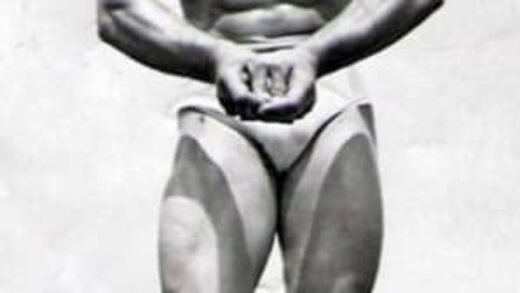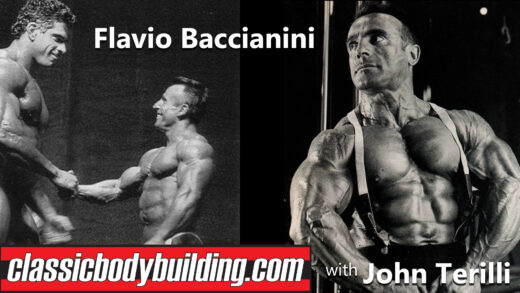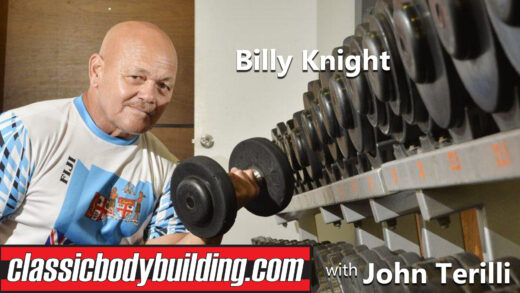As has been discussed many times previously, before the days of the internet our connection to the bodybuilding world was through magazines. They were our holy grail, our access to the stars of bodybuilding and everything that was related to bodybuilding. Training routines, dietary tips and wonderfully entertaining editorials and contest reports. It was our fix each month, the excitement as you turned the cover hard to describe but understood perfectly by those who can relate to it.

Most of the members will pick out Joe Weider and his titles as their favourite, Flex and Muscle & Fitness are two of my preferred indulgences. There were many others too and amongst them was one called Iron Man. Iron Man magazine will also be a firm favourite with many, especially those of the older generation. Iron Man was the brainchild of a very important gentleman in bodybuilding history called Peary Rader.
Peary Rader was born on the 17th of October 1909 in Peru, Nebraska. The oldest of four children, as a young boy Peary was extraordinarily skinny and lacking in strength and vigour. The family moved to Alliance Nebraska when Peary was four years old and he would see out his life here. He had a desperate desire to develop size and gain strength. Yet every method and routine he tried yielded little in the way of results. His father bought him a Farmer Burns wrestling course when he was 12 but it did nothing to help him in his quest. After becoming weary of spending what little he had on various courses, Peary took the matter into his own hands and developed his own routine, unique to himself and one he honed over several years of trial and error.
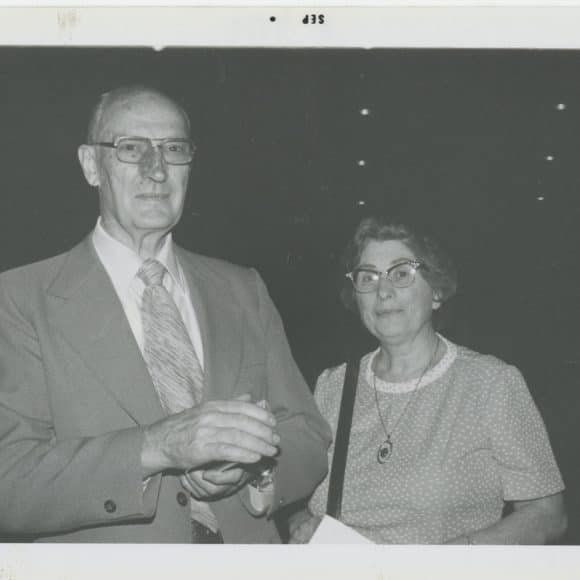
So effective was his routine that after following it for around a year he tipped the scales at 210 lbs. Gaining around 80lbs in body weight. His strength had also shot up immensely, so much so that he started competing in weightlifting meets. Peary was victorious in a number of local and regional weightlifting contests and also became proficient at a number of other lifts (such as the one-hand clean) and feats of strength. Peary was the Midwestern Heavyweight Champion for seven years, with official lifts of 220 pounds in the one-hand clean and jerk, 280 pounds in the two-hand clean and jerk, and a squat of 450 pounds (without support gear).
His results both in gaining size and strength were so exceptional that he was given the nickname ‘Iron Man’. The basis of his workout regime was the squat, more specifically the breathing squat. To this, he supplemented another basic movement, the deadlift again with particular importance to breathing so effectively it was the breathing deadlift.
Peary would also perform the jerk and added the following. Two-arm dumbbell pullover: 1 x 20, Standing barbell military press: 1 x 10-12, Barbell curl: 1 x 10-12, Barbell bench press: 1 x 10-12, Barbell bent-over row: 1 x 10-12
Sit-up: 1 x 10-12. Sets would initially be one and increase to three as he progressed. Training frequency was 3-4 times a week.
He also experimented with his diet and he found milk to be the perfect addition to his diet for gains. Drinking two quarts daily.
With a firm foundation in exercise and the results to show its effectiveness Peary took a huge gamble and launched his magazine in 1936, at a time when The Great Depression was in full effect. This would also coincide with the year he would marry Mabel Kirchner, someone who would help him with his magazine for decades to come.
During this period Peary was employed by Emerson Street School as a caretaker. The first edition is referenced as Your Physique by some sources although the more definitive source lists it as Physical Culture.
The first issue was made up of several pages relating to exercise mainly and the initial run was of 50 copies.
The printing of these 50 copies was done with an old ditto copier that Peary had brought home from work and repaired. The publishing was done twice a month and the magazine was available only through subscription, Peary mailing most of the first edition to his friends. Subscriptions initially cost 15 cents per issue.
Peary must have tapped into a rich vein of demand as the magazine readership grew incredibly quickly. The second edition adopted the iconic Iron Man title which it would keep for its entire subsequent run.
In 1939 World War 2 began but the Raders continued printing their Iron Man magazine and the readership continued to grow. Peary was now working for the railroad. It seemed the Rader’s had struck a strong chord with their readers, gaining a reputation for a dependable insight on the iron game. Iron Man Magazine contained editorials about weightlifting, powerlifting, and bodybuilding techniques, as well as information about nutrition, health, and the life-extending and character-building benefits of these exercises. The magazine was notable among its many supporters for being a less commercial publication, dense with quality information and writing. Iron Man Magazine also regularly featured editorial content about exercise and health for women.
After the war ended the Raders decided to give the magazine their full-time devotion. After searching for suitable premises they bought an old barracks house and added a cinder block basement beneath it. The basement would serve as the printing shop, Iron Man offices and a gymnasium. Their own home located at 512 Black Hills Avenue in Alliance, Nebraska, would be the home of Iron Man Magazine for the entire period the Raders published it.
Peary was the owner, editor and publisher and Mabel served as associate editor as well as penning articles on women’s health and exercise.
Such was the success of Iron Man that the Rader’s were able to branch out into other ventures which included selling their own brand of exercise equipment, books, and training courses, providing printing services, and serving as stateside ambassadors for the sale of Società Nebiolo printing equipment. Peary Rader developed and sold protein-based supplements, contributing to its mainstream acceptance and commercialisation starting in the 1950s.
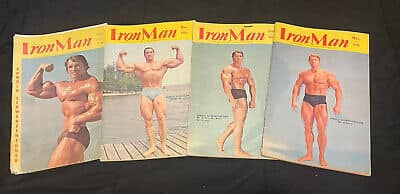
The couple eventually built a 12 000 square foot building to house all of their ever-expanding business pursuits. As Iron Man magazine grew along with their other businesses so did the Rader’s profile and standing in the bodybuilding world. With Joe Weider still in the infancy of his vision and yet to become the global phenomenon he did, the Rader’s along with Bob Hoffman was amongst the most respected and successful of all bodybuilding and weightlifting authorities.
To this end, they were in constant demand for their presence and judging capacity for bodybuilding contests and both weightlifting and powerlifting meets. Although Mabel was very knowledgeable and well versed in all aspects of bodybuilding and weightlifting she had never competed in either, unlike Peary who had been a competitive weightlifter.
This didn’t deter Mabel who studied for and then successfully applied for her AAU referee’s certificate. This allowed her to referee weightlifting events and judge bodybuilding contests, in the process becoming the first-ever woman to gain a National Referee card.
Mabel also advocated for more women to be involved and she was joined by her husband who echoed her sentiments for the inclusion of women in weightlifting and bodybuilding, both as competitors and referees.
The couple would also cover major bodybuilding contests for their magazine. Peary would do the write-ups on the contest and Mabel would be the photographer.
During the 1960s, Peary served in the Mid-Western Region Amateur Athletic Union (A.A.U.) Weightlifting Chair. Mabel succeeded him in the role when his term limit expired in 1969, serving in this capacity until 1976. She also served on the board of the A.A.U. Powerlifting Committee’s Women’s Committee and was the first chairwoman of the U.S. Weightlifting Federation’s Women’s Committee in 1980. In this role, she petitioned the U.S. Weightlifting
Federation Board to hold a women’s national competition. Thanks in large part to her advocacy and promotion of the idea, the first women’s national weightlifting event was held in 1981. In 1989, Peary was honoured by the Association of Oldetime Barbell & Strongmen for his outstanding contributions to physical culture.
For half a century the Raders would be faithful devotees to their Iron Man magazine. Providing informative, interesting and wholesome content for their readership. Unlike Joe Weider, the Raders as devout churchgoers refused to feature anything that could be remotely construed as ‘smut’ in their magazine, neither in the writing nor the photography. Peary asserted his magazine was something that could be left on any table and not elicit a negative reaction whether one’s child or parents were to see it.
On its fiftieth anniversary in 1986, the Rader’s sold Iron Man magazine to former bodybuilder and photographer John Balik. Peary was 77 and Mabel was 69, the couple deciding it was now time to hang up their boots and enjoy retirement.
John altered the original mission statement of the magazine and steered it toward a more focused and hardcore bodybuilding publication. Particularly notable for its exceptional photography.
In 2015 Iron Man went through another ownership change being bought by Swedish entrepreneur Binais Begovic and his wife, plastic surgeon Catherine Begovic. Under the Begovics the content shifted from bodybuilding and training to a focus on the Physique and Bikini classes and competitors in fitness competitions.
In 2018 the magazine was bought by Denny Kakos, founder of the International Natural Bodybuilding Association. Its long-time slogan of ‘inspiration, Information, transformation’ was replaced with the phrase ‘Natural Bodybuilding, Nutrition, Fitness and Health’ and the magazine went from a monthly to a quarterly (seasonal) publication schedule.
Even though Iron Man magazine has a very different focus and readership today than when launched, the name of Iron Man magazine will forever remain iconic and be a testament to the vision, hard work and unstinting devotion of the Raders. For fifty years the Rader’s would fulfil the appetite of their loyal readers with their magazine attaining a print run of 40 000 at its peak, creating a lasting piece of history and a personal legacy that will stand the test of time. The ultimate iron couple and to whom we all owe a little debt of gratitude.
